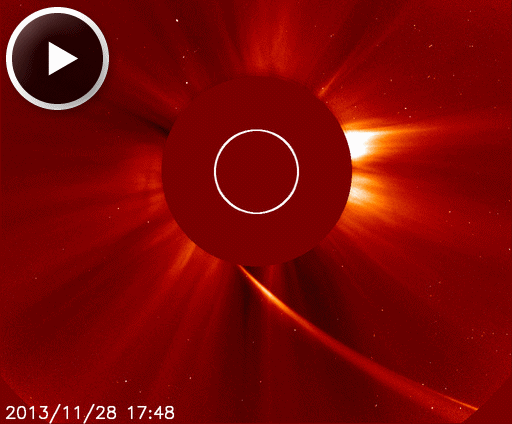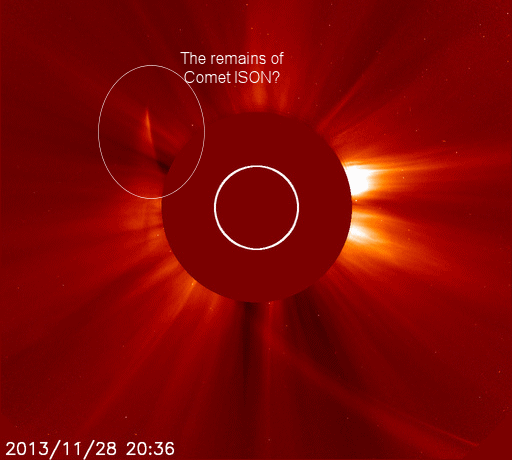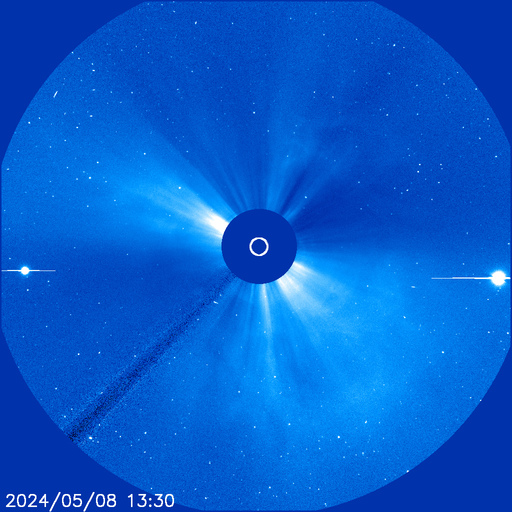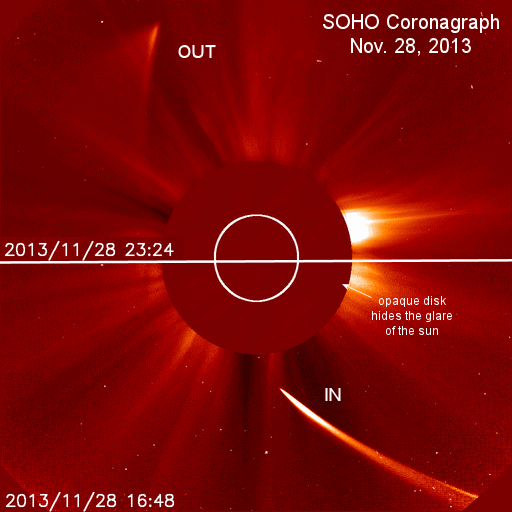Not so fast, there, varmints.
Update from Spaceweather:
'Cancel the funeral. Comet ISON is back from the dead. Yesterday, Nov. 28th, Comet ISON flew through the sun's atmosphere and appeared to disintegrate before the cameras of several NASA and ESA spacecraft. This prompted reports of the comet's demise. Today, the comet has revived and is rapidly brightening. (updated Nov. 29 @ 1800 UT):'
Before the flyby, experts had made many predictions about what might happen to the comet, ranging from utter disintegration to glorious survival. No one predicted both.
Karl Battams of NASA's Comet ISON Observing Campaign says, "[colleague] Matthew Knight and I are ripping our hair out right now as we know that so many people in the public, the media and in science teams want to know what's happened. We'd love to know that too! Right now, here's our working hypothesis:
"As comet ISON plunged towards to the Sun, it began to fall apart, losing not giant fragments but at least a lot of reasonably sized chunks. There's evidence of very large dust in the long thin tail we saw in the [SOHO coronagraph] images. Then, as ISON plunged through the corona, it continued to fall apart and vaporize, losing its coma and tail completely just like sungrazing Comet Lovejoy did in 2011. What emerged from the Sun was a small but perhaps somewhat coherent nucleus that has resumed emitting dust and gas for at least the time being."
Battams emphasizes that it is too soon to tell how big the remnant nucleus is or how bright the resurgent comet will ultimately become. "We have a whole new set of unknowns, and this ridiculous, crazy, dynamic and unpredictable object continues to amaze, astound and confuse us to no end. We ask that you please be patient with us for a couple of days as we analyze the data and try to work out what is happening."
Astrophotographer Babak Tafreshi has edited an HD video that compares views of ISON from both of SOHO's coronagraphs. "It seems the comet could become a naked eye object with several degrees of scattered tail by Dec 2nd or 3rd," he predicts. "It's not the comet of the century for sure, and fainter than the Lovejoy sungrazer in Dec. 2011, but an interesting imaging target is just a few nights away!"
http://spaceweather.com/
----------------------------------------------------------------------------------------------------------------------------
Update from SOLARHAM:
http://www.solarham.net/index.htm'Thursday was a day full of excitement and also many questions in regards to Comet ISON. The eyes of sky watchers around the world were tuned into a number of space weather websites wondering if the sungazing comet would survive its close encounter with our star. Comet ISON brightened throughout the day as it neared the sun, with a long dusty tail visible behind it in both LASCO and STEREO imagery. When it came time for the predicted perihelion (closest approach to the Sun) at 18:44 UTC, initial indications were that ISON did not survive the intense solar atmosphere and burned up. Comet ISON was declared dead by many. After a few hours had passed, what appeared to be a fragment of the comet re-emerged in both LASCO C2 and STEREO Ahead coronagraph imagery. Did ISON survive? Imagery and video below appear to support that scenario. More updates to follow regarding this event. Stay Tuned!'
Added 11/30/2013 @ 01:40 UTC
Bright CME and Comet ISON
Below is an updated image by LASCO C3 @ 00:08 UTC (Nov 30) showing a bright Coronal Mass Ejection (CME) leaving the sun, along with Comet ISON. The source of the CME appears to be from a position beyond the west limb and is directed away from Earth. In the image you also get an updated look at Comet ISON. The plasma cloud does should not have an impact on the comet.
----------------------------------------------------------------------------------------------------------------------------
Update from Never a Straight Answer:
'Continuing a history of surprising behavior, material from Comet ISON appeared on the other side of the sun on the evening on Nov. 28, 2013, despite not having been seen in observations during its closest approach to the sun.
As ISON appeared to dim and fizzle in several observatories and later could not be seen at all by NASA's Solar Dynamics Observatory or by ground based solar observatories, many scientists believed it had disintegrated completely.
However, a streak of bright material streaming away from the sun appeared in the European Space Agency and NASA's Solar and Heliospheric Observatory later in the evening. The question remains whether it is merely debris from the comet, or if some portion of the comet's nucleus survived, but late-night analysis from scientists with NASA's Comet ISON Observing Campaign suggest that there is at least a small nucleus intact.'
[






